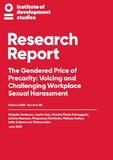The Gendered Price of Precarity: Voicing and Challenging Workplace Sexual Harassment
| dc.contributor.author | Oosterom, Marjoke | |
| dc.contributor.author | Huq, Lopita | |
| dc.contributor.author | Namuggala, Victoria | |
| dc.contributor.author | Nazneen, Sohela | |
| dc.contributor.author | Nankindu, Prosperous | |
| dc.contributor.author | Sultan, Maheen | |
| dc.contributor.author | Sultana, Asifa | |
| dc.contributor.author | Azim, Firdous | |
| dc.coverage.spatial | Bangladesh | en |
| dc.coverage.spatial | Uganda | en |
| dc.date.accessioned | 2022-06-07T09:10:44Z | |
| dc.date.available | 2022-06-07T09:10:44Z | |
| dc.date.issued | 2022-06-07 | |
| dc.identifier.citation | Oosterom, M.; Huq, L.; Namuggala, V.; Nazneen, S.; Nankindu, P.; Sultan, M.; Sultana, A. and Azim, F. (2022) The Gendered Price of Precarity: Voicing and Challenging Workplace Sexual Harassment, IDS Research Report 88, Brighton: Institute of Development Studies, DOI: 10.19088/IDS.2022.030 | en |
| dc.identifier.isbn | 978-1-78118-989-4 | |
| dc.identifier.issn | 0141-1314 | |
| dc.identifier.uri | https://opendocs.ids.ac.uk/opendocs/handle/20.500.12413/17448 | |
| dc.description.abstract | There is a strong belief that employment is a crucial avenue for the empowerment of young women, through income, greater autonomy, and bargaining power within the family. However, experiences of workplace sexual harassment undermine these potential gains. This qualitative study among agro-processing factory workers and domestic workers in Uganda and Bangladesh demonstrates that sexual harassment is widespread in both formal and informal workplaces, while domestic workers are particularly vulnerable to its most severe forms. Women’s agency to challenge harassment is severely constrained by social and gender norms. Most find that the best possible strategy is to avoid and prevent physical forms of sexual harassment from happening. Language is essential for voicing and challenging sexual harassment, but the study shows that social and gender norms constrain young women in articulating transgressive and inappropriate behaviour by men. Many women hide detail, deliberately use euphemisms, and even lack a vocabulary to explain what happened to them, ultimately limiting opportunities for redressal. At the same time, formal institutions are failing young female workers. Local authorities in both countries reproduced prejudice about women ‘inviting’ sexual attention, whereas the police are generally distrusted because of corruption and the need for bribes. To tackle sexual harassment in the workplace, multipronged strategies are needed that target employers and government actors. The right policies and adequate safeguarding and reporting mechanisms need to be implemented, whereas programmes need to support women to help them gain the confidence to speak about sexual harassment and support (collective) action. Longer-term strategies need to address gender norms that condone sexual harassment. | en |
| dc.description.sponsorship | British Academy (Grant reference number YF/190009) | en |
| dc.language.iso | en | en |
| dc.publisher | Institute of Development Studies | en |
| dc.relation.ispartofseries | IDS Research Report;88 | |
| dc.rights | This is an Open Access report distributed under the terms of the Creative Commons Attribution Non Commercial 4.0 International licence (CC BY-NC), which permits use, distribution and reproduction in any medium, provided the original authors and source are credited, any modifications or adaptations are indicated, and the work is not used for commercial purposes. | en |
| dc.rights.uri | http://creativecommons.org/licenses/by-nc/4.0/ | en |
| dc.subject | Children and Youth | en |
| dc.subject | Gender | en |
| dc.subject | Politics and Power | en |
| dc.subject | Rights | en |
| dc.subject | Work and Labour | en |
| dc.title | The Gendered Price of Precarity: Voicing and Challenging Workplace Sexual Harassment | en |
| dc.type | IDS Research Report | en |
| dc.rights.holder | Institute of Development Studies | en |
| dc.identifier.team | Power and Popular Politics | en |
| dc.identifier.doi | 10.19088/IDS.2022.030 | |
| dcterms.dateAccepted | 2022-06-07 | |
| rioxxterms.funder | Default funder | en |
| rioxxterms.identifier.project | Default project | en |
| rioxxterms.version | VoR | en |
| rioxxterms.versionofrecord | 10.19088/IDS.2022.030 | en |
| rioxxterms.funder.project | 9ce4e4dc-26e9-4d78-96e9-15e4dcac0642 | en |
Files in this item
This item appears in the following Collection(s)
-
IDS Research [1671]
Except where otherwise noted, this item's license is described as This is an Open Access report distributed under the terms of the Creative Commons Attribution Non Commercial 4.0 International licence (CC BY-NC), which permits use, distribution and reproduction in any medium, provided the original authors and source are credited, any modifications or adaptations are indicated, and the work is not used for commercial purposes.


